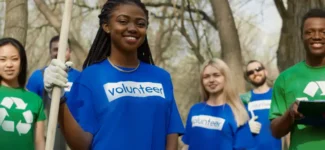For nonprofit organizations looking to increase the sophistication and efficacy of their fundraising practices, one important thing to remember is that donors have different preferences for how they like to engage with the causes they support. For instance, some donors may prefer receiving email updates, while others may enjoy receiving handwritten letters in the mail. By reaching out to supporters through a variety of communication channels, including email, social media, online ads, and direct mail, you can cater to these preferences, give supporters the best experience possible, and maximize your fundraising potential.
In this article, we’ll explore what multichannel donor outreach is and how you can use it to pursue your purpose. And if you’re looking for more advice on how to acquire, engage, and retain more of your donors over time with a great multichannel experience, check out our complete Guide to acquiring and retaining new donors for more expert tips on the right mix of technology and tactics to meet your goals.
What is multichannel donor outreach?
Multichannel donor outreach is the process of using multiple communication channels, such as email, direct mail, social media, and mobile, to engage with donors. With multiple touchpoints, you can reach as many prospective supporters as possible and increase your fundraising potential.
What is the ideal frequency for multichannel donor outreach?
The ideal frequency for multichannel donor outreach varies depending on an organization’s size, goals, and donors’ preferences. Try to strike a balance between staying top of mind with donors and not overwhelming them with too many messages.
Nonprofits just starting on their multichannel journey typically aim for 1-2 communications per month per channel, but if you’re ready to make your multichannel outreach more sophisticated, we recommend adjusting your message frequency and channel mix based on your results and on your organization’s needs at a given time. For instance, during campaigns like GivingTuesday, it’s acceptable — even expected — to send multiple messages over the course of a few days. However, if you see donors begin to unsubscribe from your messages and you aren’t in the midst of a major campaign, consider experimenting with sending fewer messages to avoid saturating their inboxes.
4 tips for optimizing multichannel donor outreach
With the basics of multichannel donor outreach in mind, you can begin crafting your campaigns and appealing to donors. Use these four tips for the best results:
Tip 1: identify a target audience
Before launching a multichannel marketing strategy, take the time to identify your target audience. We typically don’t recommend sending the same exact message to every single donor. Getting clear on who your target audience is for your messages will ensure that your time and resources go toward people who are most likely to support your cause.
To identify your target audience, begin by:
- Analyzing donor data. Scan through your constituent relationship management (CRM) platform or database to find and create lists of donors you already have who are highly engaged and invested in your current initiative. For instance, if you’re launching a capital campaign to build a homeless shelter, you’d target major donors and active volunteers if your data shows that those segments are the likeliest to respond.
- Conducting prospect research. Prospect research is the process of using public records to determine a person’s capacity and willingness to give to your cause. After taking into account both philanthropic and wealth indicators, you can target people outside of your supporter base who you know will respond positively to your cause and your appeals.
- Solicit feedback. Send out surveys to current supporters to gather feedback about their communication preferences. This can help you narrow down which platforms to use for your outreach.
Pro tip: your donor database should help you maintain accurate lists of donors. Some even let you create not just static lists, but also dynamic lists that change to include or exclude supporters by criteria you set. This can be a great time-saver for busy nonprofit staffers.
Once you identify your nonprofit’s target audience, begin tailoring your outreach to their preferences, motivations, and interests.
Tip 2: personalize your messages
Tailoring your messages to individual donors can increase engagement and responsiveness. Start by using segmentation to group donors based on shared characteristics and personalize your messages according to their unique needs and interests.
Just a few common donor segments for multichannel donor outreach include:
- New donors: new donors require specialized communications that inspire their continued involvement. A “welcome series” can be a great way to provide them with relevant information about the impact of their donation, areas of your work that they may not know about, and opportunities for future engagement.
- Major donors: speak to the impact that major donors have on your organization and offer exclusive opportunities that align with their level of giving.
- Lapsed donors: re-engage lapsed donors by expressing your appreciation for their past involvement, giving them a low-effort ask (like sharing a social media post, taking a two-question survey, or signing a petition), and encouraging them to give again.
You can also segment donors based on their geographic location, employment status, or volunteer history, and other behavioral and demographic data depending on your needs. For example, while promoting a hybrid fundraising event, you might send in-person invitations to supporters within your community and virtual invite links via email to those living outside of the area. This level of personalization will more effectively engage supporters because you’re showing them you know them and want to offer them a great experience.
Tip 3: create a consistent message across channels
Sending the same core message across multiple channels is an effective strategy for nonprofits looking to reach a wider audience and maximize engagement. However, it’s still important to adapt your wording, visuals, and communication style to different channels and platforms. For example, a message sent via email might be longer and more detailed, while a social media post might be shorter and more visually engaging.
Let’s say you run an animal shelter and your goal is to drive traffic to the donation form on your website. Here’s how you could start creating a consistent message across the following channels:
- Web: create a dedicated landing page for the donation form. Then, embed pop-ups, lightboxes, or banners throughout your main website encouraging users to visit the page.
- Email: write a longer, more detailed newsletter with images of animals, testimonials from volunteers, and a direct link to the donation form.
- Direct mail: craft a visually appealing postcard that describes your need for donations and includes a QR code to your donation form.
- Social media: post images and videos of the animals in your care along with a relevant hashtag and a call-to-action (CTA) to visit the link in your bio to access the donation form.
Maintain consistency in your messaging, tone, branding, and overall theme across communication channels. Doing so will strengthen your message, improve your brand recognition, and build trust with supporters. Think of it like this: you want each supporter to know exactly which organization and which campaign they’re looking at every step on their way to making a donation, from your letter in the mail to your email to your donation page.
Tip 4: evaluate and adapt
Track the success of your multichannel outreach strategy and make adjustments to continuously improve your performance. Some common marketing metrics to track for multichannel donor outreach include:
- Conversion rate: the percentage of people who took a desired action, such as donating, out of the total number of people who were reached through a particular channel.
- Response rate: the percentage of recipients who responded to your outreach out of the total number of people who received the message.
- Return on Investment (ROI): the amount of revenue generated or money saved as a result of your outreach efforts, compared to the cost of those efforts.
- Engagement rate: the number of interactions (likes, comments, shares) that your outreach received on social media, divided by the total number of people who viewed the message.
- Acquisition cost: the total cost of acquiring a new donor or supporter, including the cost of outreach efforts.
Experiment with different strategies and channel mixes to see what works best for your organization and audience, and adjust your outreach tactics based on the insights you gather in your donor database for the best possible results. Storing all of your donor data in one place helps you streamline your work, so everyone who talks to donors knows where to look for information about them. It also helps you pull more accurate reports on your successes more easily. Less stress for staff, board members, and volunteers; more focused and personalized messages for your supporters — it’s a win-win.
A final note about multichannel donor outreach
Multichannel donor outreach can be a highly effective way for nonprofits to engage with their supporters and raise more funds. By leveraging multiple communication channels, tailoring outreach to specific donor segments, and giving supporters a great experience with support from the right technology, you can build stronger relationships with your donors and propel your organization to its peak impact.
Craving more insights about how to make sure your multichannel donor outreach strategy is helping you build more support over time? Download this Guide to acquiring and retaining new donors for some tried-and-true tips!




